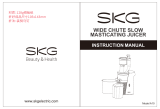
Installation and operation
12 / 18 150184
blender. If, however, a juice needs the banana taste, banana should be
squeezed first or second in the line. Thanks to blending with other juices, the
banana nectar may drip a bit easier. Though, there may be frothing present in
the process.
• When squeezing juice from small fruit, for example, grapes or strawberries,
place them in the appliance in the handful size of portions and avoid throwing
them in one by one. This helps to obtain better results.
• Please remember that red beets dye all other fruit and vegetables. When
producing many different juices, the red beet juice should be squeezed at the
end, to avoid dying all other juices.
• The apple juice will quickly acquire a bronze colour in the open air; thus, add a
drop of lemon juice.
• The juice is best served directly after preparation, as with time in the open air
juices lose their tastes and nutritional values.
• Never put ice cubes nor frozen fruit in the hopper.
Before the first use
1. Before the first use, thoroughly clean the detachable elements of the appliance
(lid, pusher, sieve base, sieve basket, plastic beaker and dregs container),
observing indication in section 6 "Cleaning".
2. Rinse the washed elements in clean water and then wipe with a linen-free cloth
or leave to dry in open air.
Assembly
1. Place the motor block (9) on a suitable surface.
2. Place the sieve base (11) on the motor block (9).
3. Place the sieve basket (12) in the sieve base (11), so that it is securely fitted on
the motor drive (5).
4. Now place the lid (3) on the sieve basket (12).
5. Secure the lid with the two safety levers (10), by turning them up and latching
them in the recesses provided to this end in the lid (3).
When the safety levers are correctly locked, the safety switch on the motor block
will be activated. As soon as the safety levers are released, the safety switch is
deactivated and the motor is off.
6. Place the dregs container (1) under the lid (3).
7. Place the plastic beaker (4) under the outlet in the sieve base (11).
Appliance start-up




















